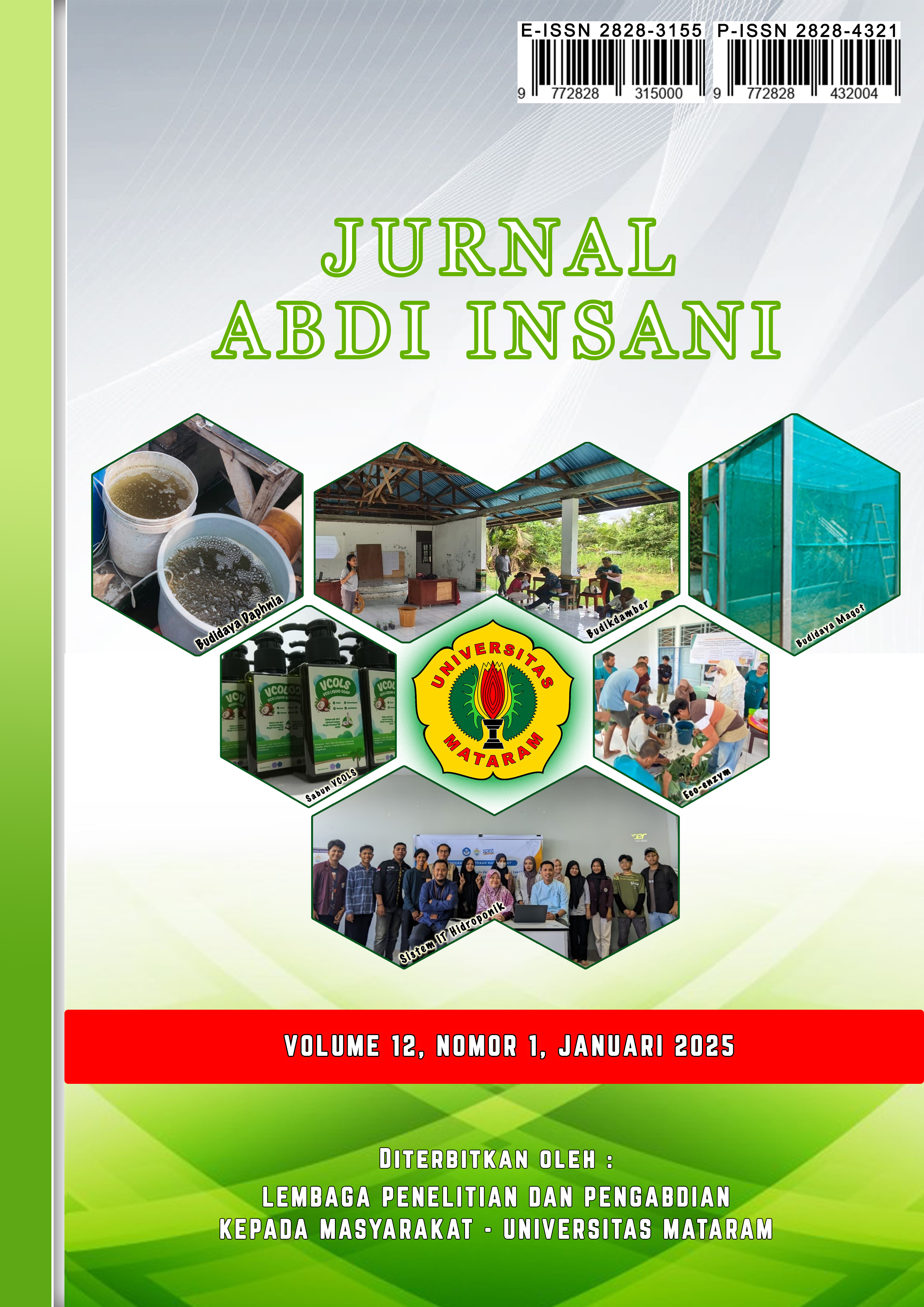PELATIHAN BUDIDAYA IKAN DAN SAYURAN DALAM EMBER (SISTEM AQUAPONIK) DI KAMPUNG MOSSO, DISTRIK MUARA TAMI, KOTA JAYAPURA
DOI:
https://doi.org/10.29303/abdiinsani.v12i1.1761Keywords:
Training, Budidamber, Catfish, Mosso Villange, Jayapura CityAbstract
Mosso is one of the villange in Muara Tami District, Jayapura City, Papua Province and it is aslo located in in the border between Indonesia and Papua New Guinea. The economy activities to support the local people’s livelihhod living in Mosso village is a tradisional farmers and the majority of them are farmers with subsistence agriculture. The development in Mosso village is face the challenge due to the capacity of local people and this issue leads to the limitation of economic activities . Budidamber is a combination technique of cultivating fish and vegetables in one container and this technique is also environmentally friendly that is promoted to apply in Mosso village. Catfish is one of commodities that has a high demand among Indonesia People. The reason why catfish and vegetables because the maintenance is easy and simple. This community service is aim to enhance the capacity building of local people in Mosso in terms of skills and knowledge about Budidamber so it can be benefit to their economic activities in household level. This community service is also aim to motivate local people in Mosso to do a simple cultivating fish with the limited land. The community service is taken place in Mosso Village, Muara Tami District Jayapura City on September 2023. The method of this activities is socialization and demonstration the practical of Budidamber. The material of this activities is delivered by some lecturer from Faculty of Agriculture, Forestry and Marine Ottow Geissler University related to the development of Budidamber such as design method, assembly technique, feeding technique and nutrition which is contain in Catfish and Water Spinach. After delivering the material, further training is carried out. It is started with an introduction to tools and materials. Budidamber is an effective system and can be implemented without requiring a large budget or capital. It is hoped that this activity can also increase community knowledge in utilizing empty land in the yard and increase food security with the Aquaponics system
Downloads
References
Anis, M. Y., & Dyah, H. (2019). Pemberian pakan komersial dengan penambahan EM4 (Effective Microorganisme 4) untuk meningkatkan laju pertumbuhan lele (Clarias sp.). Jurnal Riset Biologi dan Aplikasinya, 1(1), 1–8.
Fajeriana, N., & Kadir, M. A. A. (2023). Sistem akuaponik ikan lele dan kangkung dalam ember sebagai solusi kemandirian pangan di masa pandemi. Jurnal Panrita Abdi, 7(2), 238–248.
Hasan, Z., Andriani, Y., Dhahiyat, Y., Sahidin, A., & Rubiansyah, M. R. (2018). Pertumbuhan tiga jenis ikan dan kangkung darat (Ipomoea reptans Poir) yang dipelihara dengan sistem akuaponik. Jurnal Iktiologi Indonesia, 17(2), 175–182.
Karimah, U., Samidjan, I., & Pinandoyo. (2018). Performa pertumbuhan dan kelulushidupan ikan nila GIFT (Oreochromis niloticus) yang diberi jumlah pakan yang berbeda. Journal of Aquaculture Management and Technology, 7(1), 128–135.
Mubarakah, S., & Yulis, D. A. (2024). Melatih keterampilan santri melalui budidaya ikan dalam ember (Budikdamber) di Pondok Pesantren Riyadhusholihin Cimanuk-Pandeglang. Jurnal Community of Urban Development, 2(1), 26–32.
Pratopo, L. H., & Thoriq, A. (2021). Produksi tanaman kangkung dan ikan lele dengan sistem akuaponik. Paspalum: Jurnal Ilmiah Pertanian, 9(1), 68–76.
Rokhmah, N. A., Ammatillah, C. S., & Sastro, Y. (2014). Mini akuaponik untuk lahan sempit di perkotaan. Buletin Pertanian Perkotaan, 4(2), 32–40.
Scabra, A. R., Wahyudi, R., & Rozi, F. (2021). Introduksi teknologi budidaya ikan dalam ember (Budikdamber) di Desa Gondang Kabupaten Lombok Utara. Jurnal Pengabdian Perikanan Indonesia, 1(2), 171–179. https://doi.org/10.29303/jppi.v1i2.187
Scarba, A. R., Marzuki, M., Setyono, B. D. H., & Mulyani, L. F. (2022). Pemanfaatan teknologi Budikdamber (Budidaya Ikan dalam Ember) sebagai model urban farming berkelanjutan. Jurnal Pengabdian Magister Pendidikan IPA, 5(1), 45–53.
Setijaningsih, L., & Suryaningsih, L. H. (2015). Pemanfaatan limbah budidaya ikan lele (Clarias batrachus) untuk ikan nila (Oreochromis niloticus) dengan sistem resirkulasi. Jurnal Ilmu-Ilmu Hayati, 14(3), 287–293.
Setijaningsih, L., & Umar, C. (2015). Pengaruh retensi air terhadap pertumbuhan ikan nila (Oreochromis niloticus) pada budidaya sistem akuaponik dengan tanaman kangkung. Jurnal Ilmu-Ilmu Hayati, 14(3), 267–275.
Surtinah, R. N. (2017). Pemanfaatan pekarangan sempit dengan hidroponik sederhana di Pekanbaru. Jurnal Pengabdian kepada Masyarakat (PKM), 23(2), 274–278.
Tahapari, E., & Suhenda, N. (2009). Penentuan frekuensi pemberian pakan untuk mendukung pertumbuhan benih ikan patin Pasupati (Pangasius sp.). Berita Biologi, 9(6), 42–48.
Tustiyani, & Sinaga. (2018). Sosialisasi sistem vertiminaponik di Desa Cidatar, Kecamatan Cisurupan Kabupaten Garut. Jurnal Pengabdian dan Pemberdayaan Masyarakat, 2(2), 23–30.
Widyastuti, Y. R. (2008). Peningkatan produksi air tawar melalui budidaya ikan sistem akuaponik. Prosiding Seminar Nasional Limnologi IV LIPI, 62, 73–80.




















